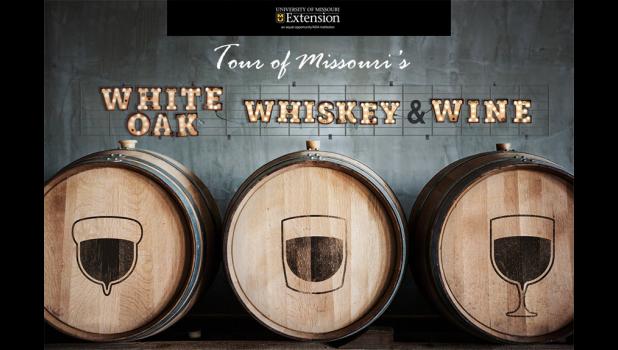Spirited tour highlights Missouri's white oak, wine and whiskey, Oct. 28
Missouri has it all: wine, whiskey and white oak.
University of Missouri Extension will toast Missouri’s unique contributions to the wine and whiskey industry during the first White Oak, Whiskey & Wine tour Saturday, Oct. 28.
MU Extension forester Hank Stelzer and MU Extension viticulturist Dean Volenberg lead the one-day tour through mid-Missouri.
The tour takes attendees to a white oak forest, a stave mill and two cooperages where wine and whiskey barrels are assembled. The event wraps up at a river bluff winery. “They will see it from start to finish,” says Stelzer.
Artisans craft white oak stave logs from Missouri into more than 1.5 million barrels each year. The barrels go to some of the most prestigious wineries and distilleries in America and Scotland, he says.
With rolling hills, picturesque views and small winery charm, Missouri wine country is a popular tourist destination, says Volenberg. Missouri’s 11 wine trails feature more than 130 wineries. Missouri wineries produce 7 percent of the country’s wine on 1,700 acres of grapes. The state’s $1.76 billion wine industry employs nearly 15,000 people, according to the Missouri Wine and Grape Board.
The tour by coach bus highlights the town of Higbee in Randolph County. Attendees will see how stave logs are processed and made ready for the cooper. There are fewer than 50 master coopers in the United States; Higbee boasts two of them. The Oak Cooperage, owned by Silver Oaks Cellars of Oakville, Calif., produces barrels for the company’s Napa Valley winery. Barrel 53 Cooperage produces barrels for distilleries across the region. Lunch is provided at The Oak Cooperage.
The tour concludes at the Les Bourgeois Vineyards and Winery at Rocheport. There, attendees will see the barreling of wine and learn how the white oak barrel imparts its unique traits to a wine’s character. They also will also hear from distillers from Wood Hat Spirits, a Montgomery County craft distillery. The distillery’s artisans use unique heritage grains and fruits, including black walnut instead of the yellow corn used by most distilleries. Participants of legal age will have the opportunity to taste the fruits of both the vintner’s and distiller’s labor.
The tour begins 8:30 a.m. Saturday, Oct. 28, at Hilton Garden Inn next to the Bass Pro Shop in north Columbia, and will return to the hotel around 4:30 p.m. Cost is $50 per person and includes transportation, lunch in Higbee and tasting at Les Bourgeois. A block of rooms has been reserved until Oct. 3 at the Hilton Garden Inn for interested tourgoers. Hotel reservations are the responsibility of the individual.
Seating is limited to 40 people. To register for the tour, contact Sharon Burnham, MU School of Natural Resources, at 573-882-7242 or burnhams@missouri.edu.
How barrels are made
The wood cells of white oak trees contain tyloses that make the wood waterproof. “These gumlike substances plug the early-wood pores of the heartwood to prevent leaking,” says Hank Stelzer, University of Missouri Extension forester. In addition to being practical, white oak barrels also impart complex flavors and aromas to their contents.
White oak stave logs represent a small amount of the timber harvested in timber sales. Logs used in barrels must be a certain length and free of defects such as knots.
At the stave mill, workers cut logs into approximately 39-inch lengths, which are quartered lengthwise into four bolts. The quartered stave bolts are sawed into flat, “quarter-sawn” stave blanks. Heading bolts, used to make the tops and bottoms of barrels, are about 20 inches long and come from stave bolts trimmed of defects.
The wood for wine barrels air-dries for 24-36 months to season in a way that kiln-drying cannot. Wood for whiskey barrels dries for only 30-40 days and can finish drying in a kiln. Header and stave blanks are planed to bring back the lighter color of the wood and make the finished barrel more resistant to outside influences.
The headers—the two flat ends of the barrel—are assembled by drilling holes in the sides of the planks and inserting a wooden dowel.
The most crucial step is barrel raising. Barrels are raised when the cooper arranges approximately 32 staves in a temporary steel ring. The barrel raiser checks for even distribution of both narrow and wide staves to ensure a tight fit. Each barrel is heated over an open fire or steam to bend the staves into the barrel shape without cracking the wood. No glue is used in header assembly and raising because glues impart undesirable flavors to the finished wine or spirit.
Whiskey barrels are then charred on the inside. During the aging process, the “white dog” whiskey expands into the wood during the hot summer months and back out during the cold winters. This passing of the distilled spirit through the charred wood creates bourbon’s amber color, and caramel and butterscotch flavors. Wine barrels, on the other hand, receive a gentler light, medium or dark “toasting,” based upon the winery’s choice. Toasting gives wine a “roasted” aroma and enhances flavor by crystallizing the natural sugars in the wood.
A series of specialized machines place the finished hoops on the barrel, insert the top and bottom and drill the bunghole, through which the barrel is filled with the wine or spirit. The final steps for wine barrels are sanding and laser engraving the winery’s logo. Whiskey barrels forgo this step because they are usually stored in large buildings called rack houses that are seldom featured on tours.
To save on transportation costs, wine barrels sometimes ship as kits and are assembled at their final destination. Whiskey barrels, on the other hand, are usually delivered to the distillery fully assembled.
Source: Hank Stelzer, 573-882-4444

